The dumbbell push-up is an effective exercise for beginners and advanced lifters alike. But did you know that this simple exercise can be modified to adjust difficulty and optimize for different training results? Below, I share 11 of the best dumbbell push-up variations to build a stronger and leaner chest at home
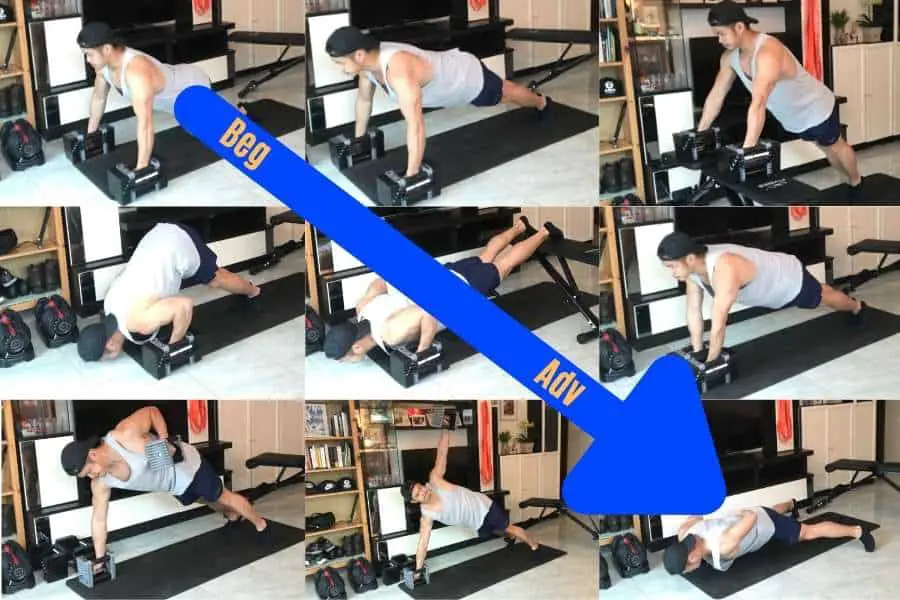
Whether your goal is to build muscle, increase strength, tone, or simply lose some weight, I got you.
Together, these 11 dumbbell push-up variations will work the chest/arms/shoulders in different ways and help you achieve any of the results I describe above!
Let’s jump straight in.
1) Dumbbell Push-Up On Knees
The dumbbell knee push-up is a novice variation of the regular dumbbell push-up. It requires the individual to get on their knees whilst performing a dumbbell push up. This supports some of the individual’s body weight and reduces the total weight taken by the arms and chest.
| Recommended Training Level: | Beginner |
| Primary Target Muscles: | Pectorals, serratus anterior, front deltoids, triceps |
| Secondary Target Muscles | Side and rear deltoids, biceps, back, abdominals |
| Good For: | Novices who cannot do the regular dumbbell push up |
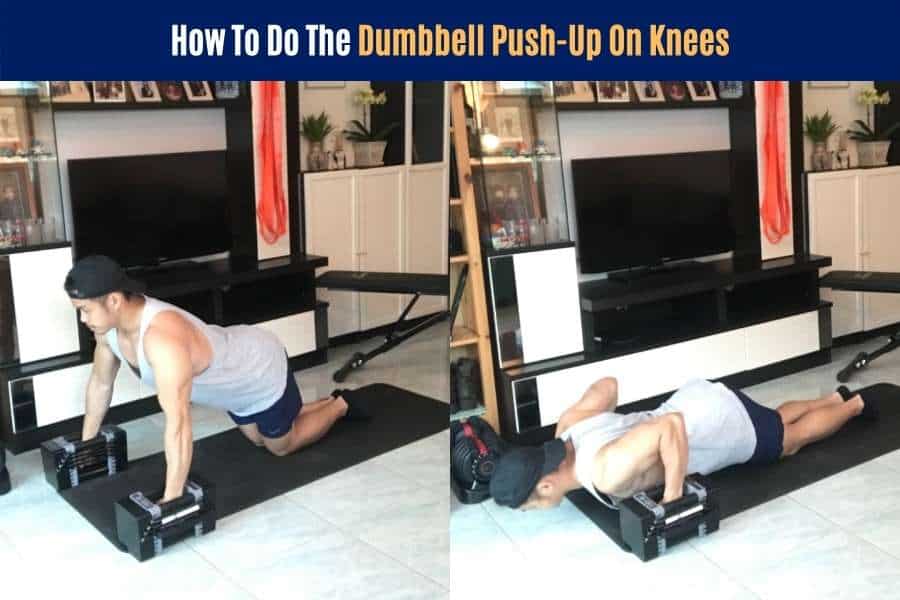
How to do dumbbell push ups on knees:
- Place two dumbbells on the floor at a shoulder-width distance.
- Get on your knees at ~1.5 feet behind the dumbbells.
- Lean forward and grip the dumbbell handles with a neutral grip (palms facing each other) and straight arms to support you weight.
- Slowly lower your chest towards the dumbbells.
- Stop when the chest comes in-line or just-below the dumbbell handles.
- Use the chest and arms to explosively push yourself back up to the starting position.
Benefits of dumbbell push ups on knees:
This is one of the best dumbbell push-up variations for beginners who have yet to master the regular dumbbell push up (which can be challenging). It works the same muscles and has the same benefits as the regular dumbbell push-up. But it’s much easier. Once you’re able to do 20-30 consecutive repetitions, you should move on to the regular dumbbell push up.
2) Regular Dumbbell Push-Up
The dumbbell push-up is one of the best variations of the traditional push-up. The raised position of the dumbbell push up puts the person in a deficit position. This makes the push up harder and more effective to perform since the chest has to sink lower towards the ground.
| Recommended Training Level: | Beginner |
| Primary Target Muscles: | Pectorals, serratus anterior, front deltoids, triceps |
| Secondary Target Muscles: | Side and rear deltoids, biceps, back, abdominals |
| Good For: | Building muscle, increasing strength, burning fat, toning |
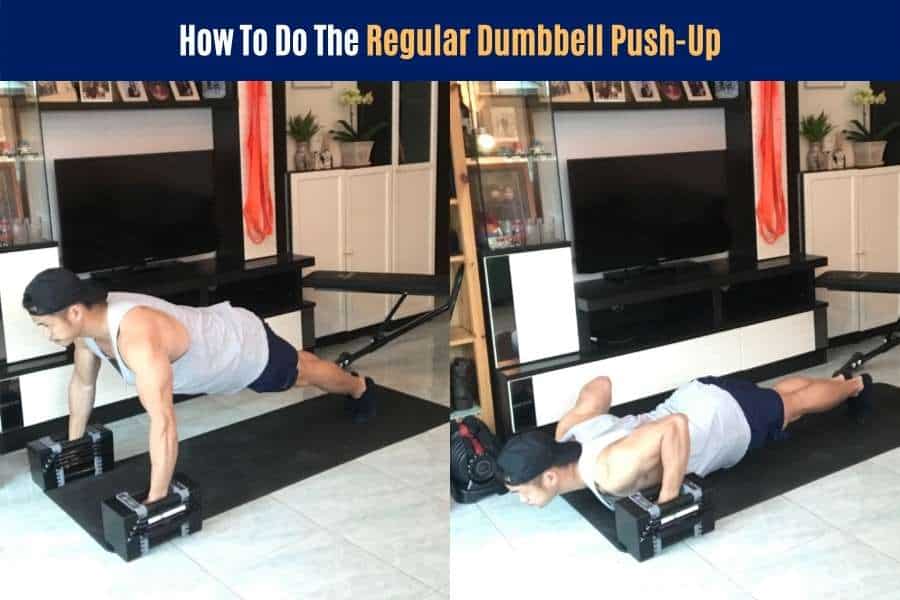
How to do regular dumbbell push ups:
- Place two dumbbells flat on the ground, parallel, and at a shoulder-width distance apart.
- Grip both dumbbell handles with a neutral grip (wrists facing in towards each other) and straight arms.
- Extend both legs backwards and distribute your rear weight onto your toes.
- Brace your core and engage your glutes to maintain a straight back.
- Slowly lower yourself towards the floor.
- Actively tuck the elbows towards the ribcage to prevent them flaring out.
- Stop when your chest is level or just-below the dumbbell handle.
- Push yourself up using your chest and arms.
Benefits of regular dumbbell push ups :
The deficit position of a dumbbell push up increases the difficulty and effectiveness of the regular push up on the floor. You get a deeper stretch in the pectorals because your chest sinks lower towards the ground. This is beneficial for muscle growth since studies have found that a bigger stretch underload promotes larger hypertrophy (muscle-building) response.
3) Dumbbell Incline Push Up
The dumbbell incline push-up is one of the most effective variations to emphasize the lower chest. The inclined angle means a greater amount of tension is shifted towards the lower pectorals. Additionally, beginners often find this variation easier to perform compared to the flat dumbbell push-up.
| Recommended Training Level: | Beginner |
| Primary Target Muscles: | Lower pectorals, serratus anterior, front deltoids, triceps |
| Secondary Target Muscles | Side and rear deltoids, biceps, back, abdominals |
| Good For: | Building muscle and strength in the lower chest, toning, fat-burning |
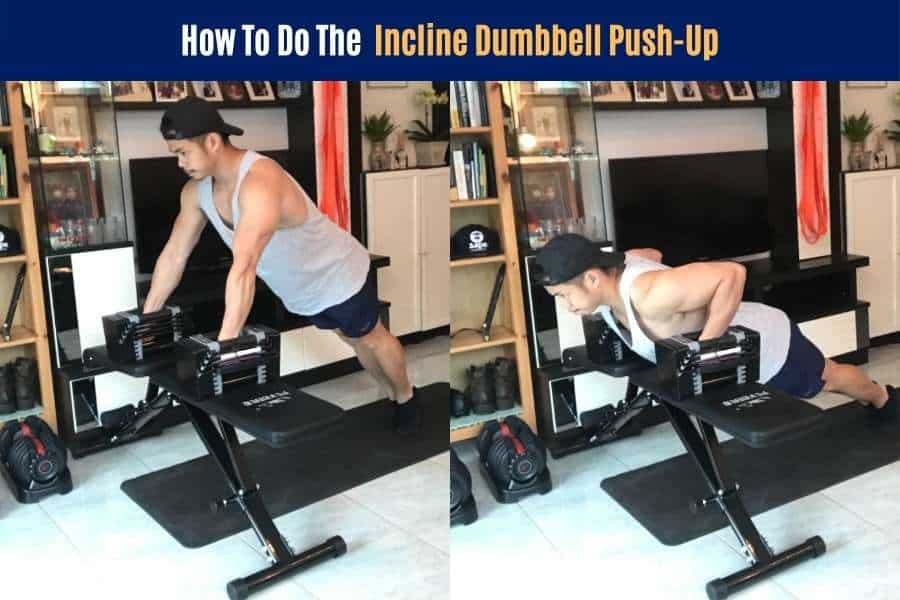
How to do dumbbell incline push ups:
- Place two dumbbells on a raised surface (e.g. a sturdy cabinet or bench) at a shoulder-width distance apart.
- Grip both dumbbells with a neutral grip (palms facing each other) and straight arms.
- Support your weight on the tips of your toes.
- Contract your glutes and core to maintain a straight and rigid torso.
- Slowly lower yourself towards the dumbbells by dropping your lower chest towards the dumbbells.
- Keep the elbows tucked into the torso to prevent them flaring out too much.
- Stop when the lower pec-line reaches the dumbbell handles.
- Push yourself back up to the starting position.
Benefits of dumbbell incline push ups:
The incline push up is a great variation of the flat push up. The inclined angle makes it easier to emphasize your lower chest rather than the mid or upper chest. This can help you build some definition in the lower chest-line. And performing the incline push-up with dumbbells makes this exercise even more effective!
4) Dumbbell Pike Or Decline Push-Up
The dumbbell pike push-up is one of the best variations for beginners to target the upper chest and shoulders. The decline angle allows greater tension to be shifted towards the upper pectorals and deltoids. More tension can be shifted onto the upper pectorals by doing the incline push-up instead.
| Recommended Training Level: | Beginner |
| Primary Target Muscles: | Upper pectorals, front deltoids, triceps |
| Secondary Target Muscles | Side and rear deltoids, biceps, back, abdominals |
| Good For: | Building muscle and strength in the upper chest, toning, fat-burning |
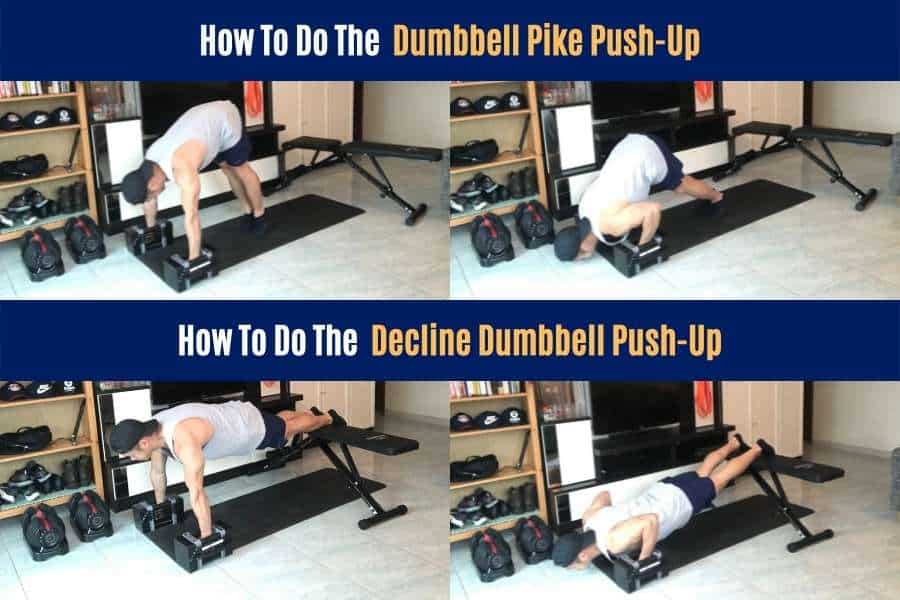
How to do regular dumbbell pike push ups:
- Place two dumbbells parallel on the floor at a shoulder-width distance apart.
- Plant your feet ~1.5 feet behind the dumbbells.
- Grip the dumbbells with a neutral grip (palms facing inside).
- Enter an upside down V-position by straightening your arms and legs, and raising your hips.
- Slowly lower your head towards the spot just in front of your dumbbells.
- Stop when your nipples are just above the dumbbell handles.
- Push yourself back up.
Benefits of regular dumbbell pike push ups :
This is one of the easier dumbbell push-up variations for a beginner to target the shoulders and upper chest. If you want to emphasize the upper chest (rather than the shoulders), then you can do the decline dumbbell push up instead. Do this by supporting your feet on a raised surface instead of simply planting them on the floor.
5) Dumbbell Push Up With A Close-Grip
Using a close-grip is one of the best dumbbell push-up variations to target the triceps and inner chest. This intermediate variation of the dumbbell push up can be difficult for beginners to perform. But it is effective for building definition in the rear arms and chest.
| Recommended Training Level: | Intermediate |
| Primary Target Muscles: | Triceps, inner pectorals, front deltoids, |
| Secondary Target Muscles | Side and rear deltoids, biceps, back, abdominals |
| Good For: | Building upper body muscle and strength with an emphasis on the arms and inner chest |

How to do close-grip dumbbell push ups:
- Place two dumbbells on the floor directly next to each other with the handles ~5 inches apart.
- Assume a regular dumbbell push up position by gripping the handles using a neutral grip (palms facing each other).
- Brace your glutes and core to maintain a straight back.
- Lower your torso by dropping your chest mid-line towards the dumbbells.
- Do not flare the elbows. Keep them tucked into the rib cage.
- Stop when the nipples are ~1 inch above the dumbbell handles.
- Push upwards by extending your arms and contracting the pectorals.
Benefits of close-grip dumbbell push ups:
This is arguably the best dumbbell push up variation to get that cut look in your arms. The triceps contribute around 70% of the total muscle mass in the upper arms. And increasing tricep size is an effective way to get that “line” of definition running from your elbows to your shoulders. Beginners will want to master the regular dumbbell push up before trying this variation.
You can check out my other post for a complete guide on how to do the dumbbell push up.
6) T-Push Up With Dumbbells
The dumbbell T-push up is one of the most effective push up variations to burn fat. Although it can be a difficult movement, forcing the person to use a lighter dumbbell weight, it targets all of the major muscle groups. This makes it a good exercise to quickly expend calories.
| Recommended Training Level: | Intermediate |
| Primary Target Muscles: | Pectorals, serratus anterior, deltoids, triceps, back, |
| Secondary Target Muscles | Biceps, abdominals, glutes, quadriceps, hamstrings |
| Good For: | Fat-burning and upper body toning |
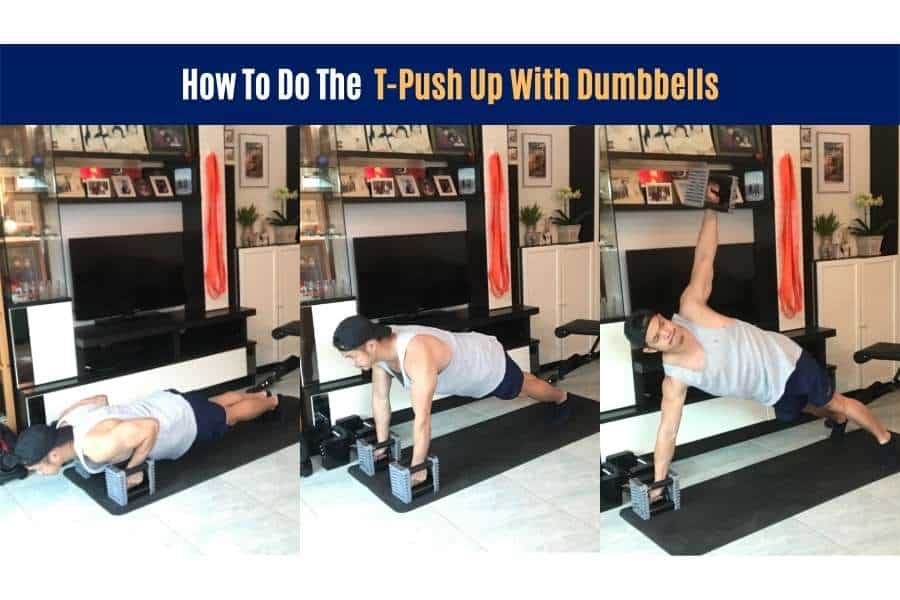
How to do dumbbell T-push ups:
- Place two dumbbells parallel on the ground at a distance that’s just narrower than shoulder-width apart.
- Assume a pushup position by gripping the dumbbell handles with a neutral grip, keeping your arms straight, and resting your rear weight on your toes.
- Lower your chest towards the dumbbells to drop your torso towards the ground.
- Keep the elbows tucked towards the rib cage.
- Stop when your chest touches the top of the dumbbells.
- Push upward by extending the arms and contracting the pectorals.
- Lift one dumbbell off the ground as you approach the top of the push up movement.
- Rotate the torso to arc the dumbbell upwards, keeping the arms straight throughout.
- Stop when the dumbbell-holding arm is perpendicular to the floor.
- Arc the dumbbells back down onto the floor and back into the starting position.
Benefits of the dumbbell T-push ups:
Many of your largest muscles are activated during this movement. Your chest, arms, and shoulders are worked isotonically (think of a standard muscle contraction), whilst your core, back, and legs are worked isometrically (think of holding a dumbbell in front of you at arm’s length and keeping it there) as they stabilize the movement. Combined, this makes for an excellent fat burner and muscle toner.
7) Dumbbell Push Up To Renegade Row
The dumbbell push-up to renegade row is one of the best variations to burn fat and tone the upper body. It combines the chest-building benefits of the push up and the back-building benefits of the row. As a result, this exercise also burns a lot of calories per movement.
| Recommended Training Level: | Intermediate |
| Primary Target Muscles: | Pectorals, serratus anterior, front deltoids, triceps, biceps back, |
| Secondary Target Muscles | Side and rear deltoids, glutes, abdominals |
| Good For: | Fat-burning and upper body toning with emphasis on the back muscles |
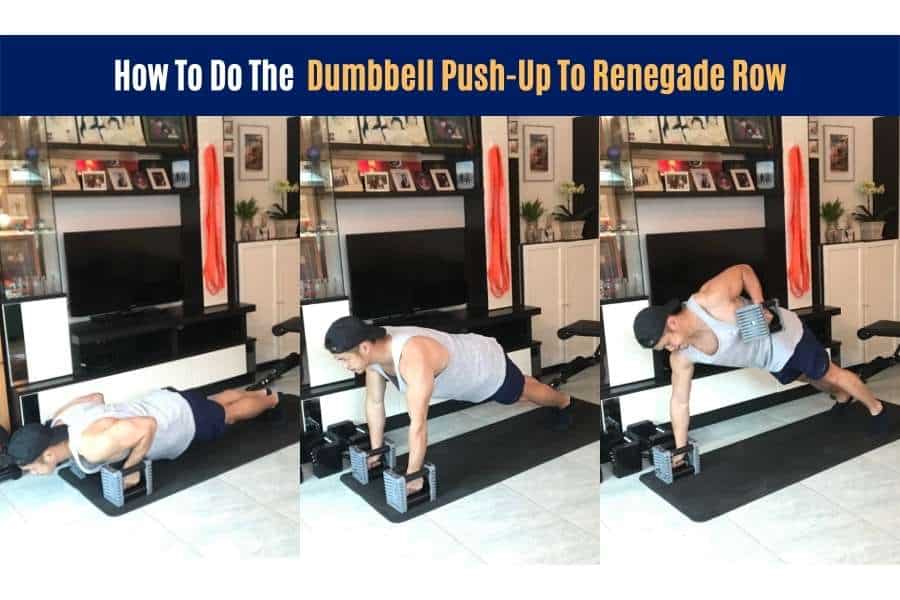
How to do dumbbell push ups to renegade row:
- Place two dumbbells parallel on the floor just narrower than shoulder-width apart.
- Assume a dumbbell push up position with your feet spread wide (for support and balance).
- Slowly lower your body towards the ground by allowing your chest to drop towards the dumbbells in a controlled manner.
- Keep your elbows tucked towards the body to stop them flaring out.
- Stop when your chest is ~1 inch above the dumbbells.
- Push upwards by extending your arms and contracting the pecs.
- At the top of the push up, keep one arm straight to support your bodyweight and pull the other dumbbell off the ground.
- Keep pulling the dumbbell until it touches your chest.
- Slowly lower the dumbbell back to the ground.
Benefits of dumbbell push ups to renegade row:
The bottom half of this movement is a typical dumbbell push up. It will help you to build chest strength and size. But the top half of the movement resembles a row. This will similarly work your back muscles. As a result of combining two big movements into one, the dumbbell push up to renegade row is also an effective fat-burner!
It’s a great addition to a dumbbell HIIT workout program (link to my complete guide) to burn fat and increase tone.
8) Dumbbell Push Up To Shoulder Press
The dumbbell push-up to shoulder press is one of the best push up variations to build upper body muscle. It combines the chest-building benefits of the dumbbell push up with the shoulder-building benefits of the overhead press. As a result, this is a great exercise to broaden the upper body.
| Recommended Training Level: | Intermediate |
| Primary Target Muscles: | Pectorals, serratus anterior, deltoids, triceps |
| Secondary Target Muscles | Biceps, back, glutes, abdominals |
| Good For: | Building upper body muscle and strength with emphasis on the chest and shoulders |
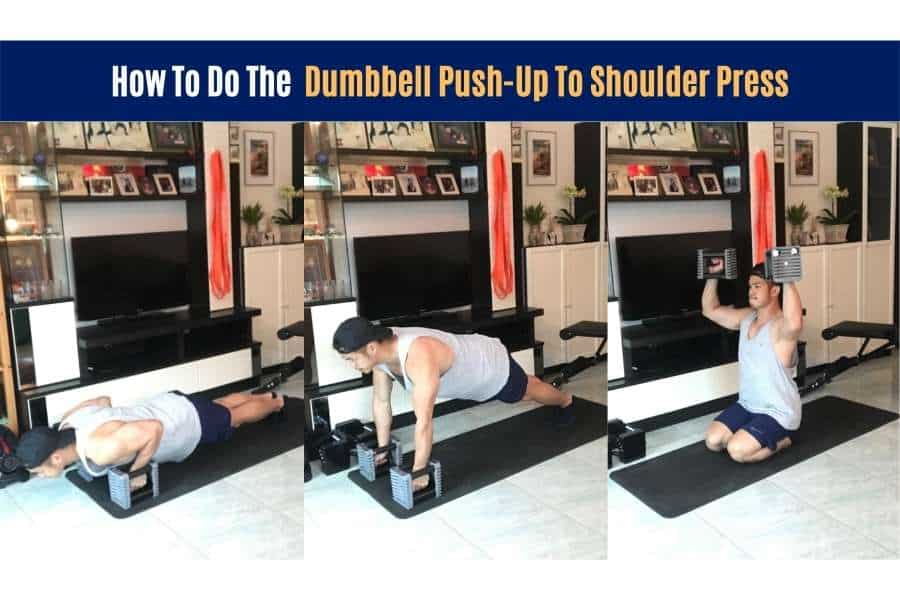
How to do dumbbell push ups to shoulder press:
- Place two dumbbells flat on the floor and parallel at a shoulder-width distance apart.
- Grip both dumbbell handles with a neutral grip (palms facing each other).
- Keep your arms straight, extend the legs back, and distribute your rear weight onto your feet.
- Engage the abs and glutes to maintain a straight back.
- Slowly lower yourself down by bringing your chest towards the floor.
- Do not flare your elbows outwards. Keep them tucked into the body.
- Stop when the chest comes in line with, or just below, the dumbbell handles.
- Push up by extending the arms and contracting the pectorals.
- Bring your hips and knees forward, sit on your knees, and press both dumbbells upwards.
- Keep your elbows tucked towards your torso as you press up.
- Lower the dumbbells back onto the floor and reassume the push up position.
Benefits of dumbbell push ups to shoulder press:
The push up is a great exercise for working the chest and the shoulder press is equally good for working the shoulders. As a result, combining both exercises should build you muscle and strength in both of these mirror muscles. This is also an energy-intensive exercise that can be used to burn fat in a HIIT-style dumbbell workout.
9) Dumbbell Push Up With Paused Reps
Paused reps are effective dumbbell push-up variations to maximize muscle size and strength in the chest and arms. Introducing a one-second pause halfway through a dumbbell push-up repetition makes the movement harder and more effective for building muscle and burning calories.
| Recommended Training Level: | Advanced |
| Primary Target Muscles: | Pectorals, serratus anterior, front deltoids, triceps |
| Secondary Target Muscles | Side and rear deltoids, biceps, back, abdominals |
| Good For: | Building muscle size and increasing strength in the chest and arms |
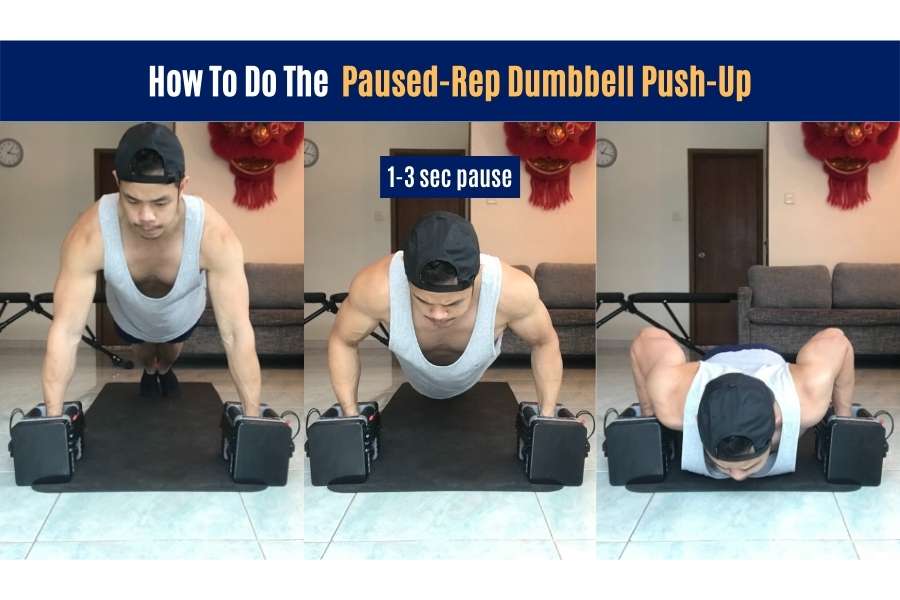
How to do dumbbell push ups with paused reps:
- Place two parallel dumbbells flat on the ground at a shoulder-width distance apart (just like with a regular dumbbell push-up).
- Grip both dumbbell handles using a neutral grip (wrists facing each other).
- Straighten your arms, extend your legs backwards, and distribute your rear weight onto your toes.
- Brace the abdominals and glutes to keep a straight back.
- Begin slowly lowering yourself down by bringing your chest towards the floor.
- Keep the elbows tucked into the torso.
- Stop half way down and hold this position for 1-3 seconds (the longer the better).
- Resume the rep by lowering your chest to a level that’s in line or just below the dumbbell handle.
- Push upwards by extending your arms and contracting the chest.
Benefits of dumbbell push ups with paused reps:
This is a variation of the dumbbell push-up takes the exercise to another level. It’s hard! But that’s what makes it so effective. You’re essentially forcing yourself to maintain a good mind-muscle connection and making your pectorals, triceps, and deltoids work harder. You’ll feel a really good pump in the chest region after doing a few sets of this exercise!
10) Dumbell Push Up With A Slow Eccentric
The dumbbell push-up with a slow eccentric phase is one of the best variations to build muscle, tone, and strength in the upper body. A slow eccentric requires the person to prolong the downward phase to around 3-5 seconds, before explosively pushing upwards.
| Recommended Training Level: | Advanced |
| Primary Target Muscles: | Pectorals, serratus anterior, front deltoids, triceps |
| Secondary Target Muscles | Side and rear deltoids, biceps, back, abdominals |
| Good For: | Building muscle, increasing strength, burning fat, toning |
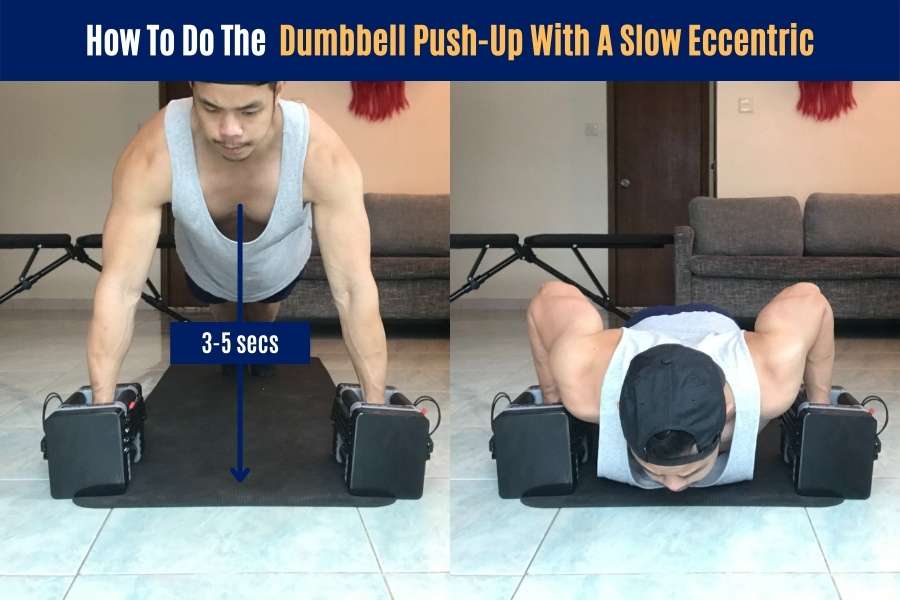
How to do dumbbell push ups with a slow eccentric:
- Assume a normal dumbbell push up position by placing two dumbbells on the floor and holding the handles with a neutral grip.
- Slowly bring your chest to the ground by flexing at the elbows to lower your torso towards the dumbbells.
- Keep your elbows tucked towards your torso to prevent them flaring out.
- The doward phase should be performed slowly and controlled. It should last at least 3 seconds.
- Stop when the chest line reaches (or just below) the dumbbell handles.
- Take a split second pause before pushing explosively up.
Benefits of dumbbell push ups with a slow eccentric:
This 2018 study has indicated that the eccentric (downward) phase is just as important (if not more), compared to the concentric (upward) phase, for stimulating the hypertrophy (muscle-building) response. Prolonging the eccentric is much harder but it will be better for building a good mind-muscle connection, building more muscle and strength, and burning calories.
11) Single-Arm Dumbbell Push Up
The single-arm dumbbell push up is the hardest, and arguably the best, push up variation to build muscle and strength in the upper body. However, it is a hard exercise to perform and unsuitable for beginners. A novice trainer should master the regular dumbbell push up before attempting this variation.
| Recommended Training Level: | Advanced |
| Primary Target Muscles: | Pectorals, serratus anterior, front deltoids, triceps |
| Secondary Target Muscles | Side and rear deltoids, biceps, back, abdominals |
| Good For: | Building muscle size and strength in the chest and arms |

How to single-arm dumbbell push-ups:
- Place a single dumbbell on the floor.
- Take both knees to the floor and hold the dumbbell with one arm using a neutral grip.
- Extend both legs backwards and take a wide stance with the feet. A wider stance helps improve balance and stability as you perform this difficult exercise.
- Slowly lower your torso by bringing your chest towards the dumbbell.
- Stop when your chest reaches in line with the dumbbell handle (or just below to make things harder).
- Push with your arms and chest to bring yourself back up.
Benefits of single-arm dumbbell push-ups:
This exercise is infamous for being extremely difficult. You should build your upper body pushing strength using the other dumbbell push up variations on this list before attempting the one-arm push up. You can also try without the dumbbells first. For those who can do it, it’s one of the best ways to build muscle and increase strength in the chest, arms, and shoulders. It’s a great exercise for those who don’t have heavy dumbbells or barbells!
You’ll need a sturdy pair of dumbbells to perform this safely.
If you’re using adjustable dumbbells, you might want to check out my other post to find out if adjustable dumbbells like the Powerblocks and Bowflex can be used for push ups.
Recommended Dumbbells For Push Ups
You’ll need a good pair of dumbbells to perform these dumbbell push-up variations safely.
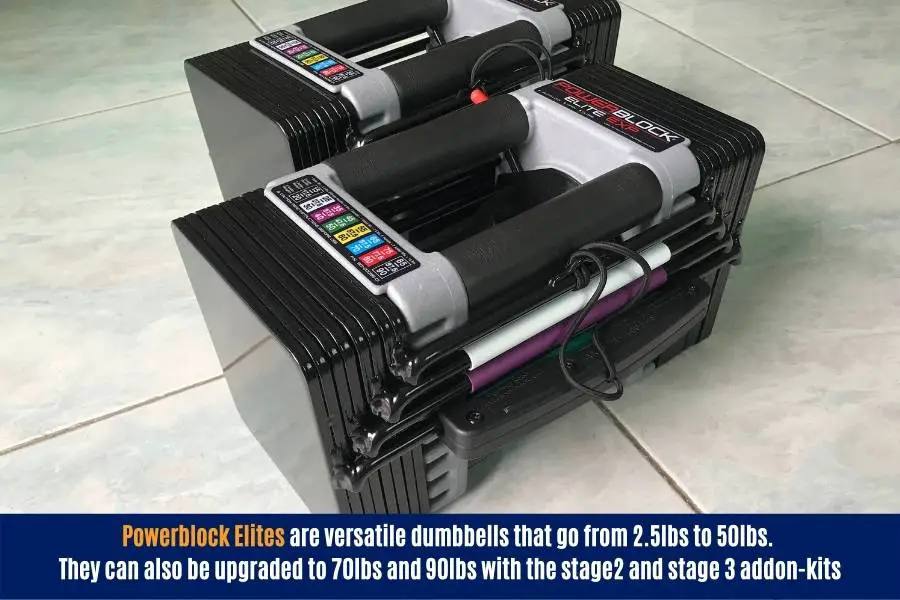
You can see I use the PowerBlock Elites in this post.
They have a flat base that prevents rolling, a sturdy handle, and the steel frame can take any bodyweight you throw at it (I weigh 165lbs and they don’t creak or give way at all).
Additionally, the handles also have one of the highest ground clearances out of all the dumbbells I’ve used. And this is great for getting the biggest stretch on your pectorals (more difficult = more effective).
They’re also suitable for heavy dumbbell bench pressing if you’re looking to build a killer chest!
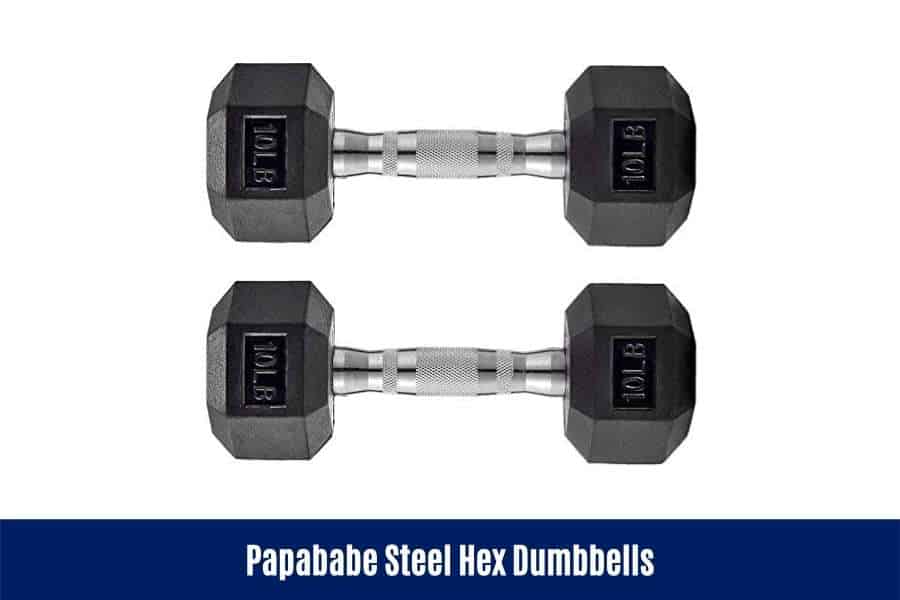
If you’re on a budget, then a simple pair of hex dumbbells like the Papapbabes also do the job.
Just be aware that a single pair of fixed-weight dumbbells like this, whilst perfect for dumbbell push ups, are extremely limited in their use (compared to adjustable dumbbells).
That’s because they don’t offer any other weight other than the pre-specified weight.
Sure, you could buy a complete set of hex dumbbells.
But getting an entire set would cost more than the Powerblocks.
That’s why I would always recommend the Powerblocks instead (they’re more versatile and cost-effective overall).
Nevertheless, a single pair of hex dumbbells ARE still cheaper than the Powerblocks when you consider the upfront cost.
Conclusion
I’ve shared 11 of the best dumbbell push-up variations for beginners to advanced lifters.
All 11 variations work the chest, arms, and shoulders to different degrees.
They can all be used to build muscle, increase strength, add definition and tone, and burn fat.
But some variations are better suited for certain training goals than others (as detailed in the post).
Which of these dumbbell push-up variations will you be trying?
Feel free to send me a message if you have any questions! You can find my details on the “contact us” page.
You may also be interested in the downloadable Kalibre Blueprint PDF which details exactly how I gained 40lbs of lean muscle (it’s 100% free!). It details the exact exercises and nutrition (with printable worksheets) I used to go from skinny to ripped!
Thanks for reading guys!
Peace Out,
Kal
(Biochemistry BSc, Biomedical Sciences MSc, Ex-Skinny Guy)


